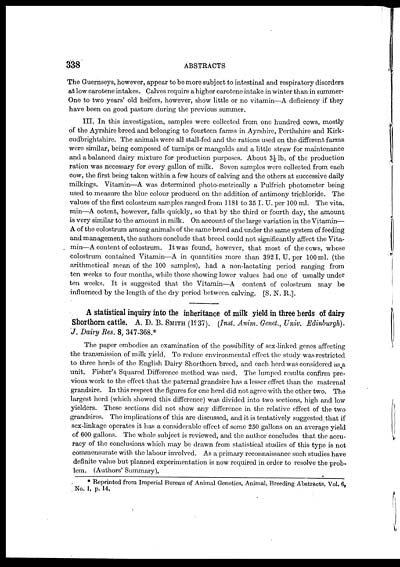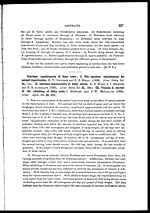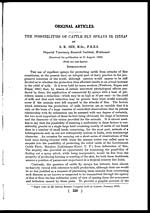Medicine - Veterinary > Veterinary colleges and laboratories > Indian journal of veterinary science and animal husbandry > Volume 9, 1939 > Original articles > Abstracts
(246) Page 338
Download files
Individual page:
Thumbnail gallery: Grid view | List view

338 ABSTRACTS
The Guernseys, however, appear to be more subject to intestinal and respiratory disorders
at low carotene intakes. Calves require a higher carotene intake in winter than in summer-
One to two years' old heifers, however, show little or no vitamin—A deficiency if they
have been on good pasture during the previous summer.
III. In this investigation, samples were collected from one hundred cows, mostly
of the Ayrshire breed and belonging to fourteen farms in Ayrshire, Perthshire and Kirk-
cudbrightshire. The animals were all stall-fed and the rations used on the different farms
were similar, being composed of turnips or mangolds and a little straw for maintenance
and a balanced dairy mixture for production purposes. About 3½ lb. of the production
ration was necessary for every gallon of milk. Seven samples were collected from each
cow, the first being taken within a few hours of calving and the others at successive daily
milkings. Vitamin—A was determined photo-metrically a Pulfrich photometer being
used to measure the blue colour produced on the addition of antimony trichloride. The
values of the first colostrum samples ranged from 1181 to 35 I. U. per 100 ml. The vita-
min—A cotent, however, falls quickly, so that by the third or fourth day, the amount
is very similar to the amount in milk. On account of the large variation in the Vitamin—
A of the colostrum among animals of the same breed and under the same system of feeding
and management, the authors conclude that breed could not significantly affect the Vita-
min—A content of colostrum. It was found, however, that most of the cows, whose
colostrum contained Vitamin—A in quantities more than 392 I. U. per 100 ml. (the
arithmetical mean of the 100 samples), had a non-lactating period ranging from
ten weeks to four months, while those showing lower values had one of usually under
ten weeks. It is suggested that the Vitamin—A content of colostrum may be
influenced by the length of the dry period between calving. [S. N. R.].
A statistical inquiry into the inheritance of milk yield in three herds of dairy
Shorthorn cattle. A. D. B. SMITH (1937). (Inst. Anim. Genet., Univ. Edinburgh) .
J. Dairy Res. 8, 347-368.*
The paper embodies an examination of the possibility of sex-linked genes affecting
the transmission of milk yield. To reduce environmental effect the study was restricted
to three herds of the English Dairy Shorthorn breed, and each herd was considered as a
unit. Fisher's Squared Difference method was used. The lumped results confirm pre-
vious work to the effect that the paternal grandsire has a lesser effect than the maternal
grandsire. In this respect the figures for one herd did not agree with the other two. The
largest herd (which showed this difference) was divided into two sections, high and low
yielders. These sections did not show any difference in the relative effect of the two
grandsires. The implications of this are discussed, and it is tentatively suggested that if
sex-linkage operates it has a considerable effect of some 250 gallons on an average yield
of 600 gallons. The whole subject is reviewed, and the author concludes that the accu-
racy of the conclusions which may be drawn from statistical studies of this type is not
commensurate with the labour involved. As a primary reconnaissance such studies have
definite value but planned experimentation is now required in order to resolve the prob-
lem. (Authors' Summary).
* Reprinted from Imperial Bureau of Animal Genetics, Animal, Breeding Abstracts, Vol. 6,
No. 1, p. 14.
Set display mode to: Large image | Zoom image | Transcription
Images and transcriptions on this page, including medium image downloads, may be used under the Creative Commons Attribution 4.0 International Licence unless otherwise stated. ![]()
| India Papers > Medicine - Veterinary > Veterinary colleges and laboratories > Indian journal of veterinary science and animal husbandry > Volume 9, 1939 > Original articles > Abstracts > (246) Page 338 |
|---|
| Permanent URL | https://digital.nls.uk/75247237 |
|---|
| Description | Covers articles from 1939. Please note that pagination starts at p.139 and plates at Plate V. |
|---|




